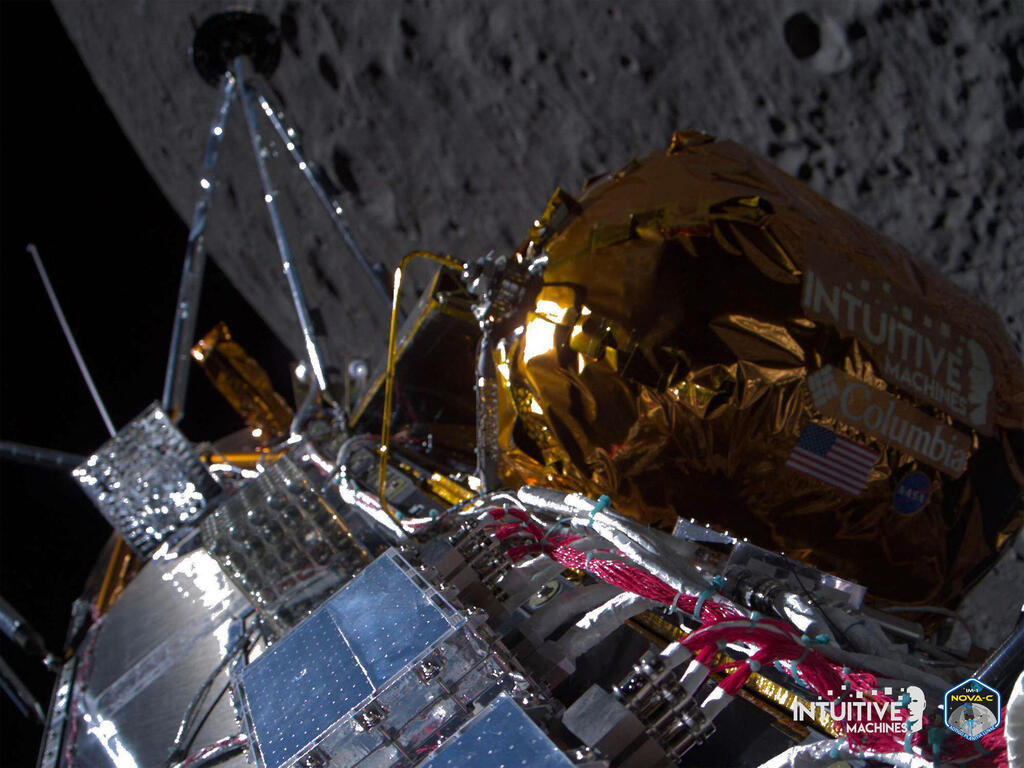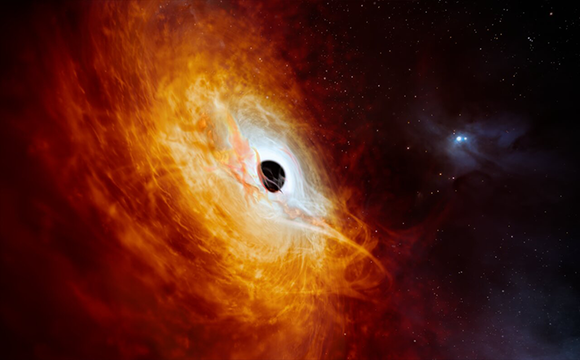Making it Intuitive
The American company Intuitive Machines' "Odysseus" lander attempted to make history by completing the first soft landing of a commercial spacecraft on the moon by early last Friday morning. The spacecraft was launched on February 15 atop a SpaceX Falcon 9 rocket and successfully completed a maneuver to enter lunar orbit. The landing took place about 190 miles (300 kilometers) from the lunar south pole, on the side facing Earth.
More stories:
Odysseus is a Nova-C model lander, an iteration of a lander that NASA previously began developing. Characterized by its substantial size, the lander boasts a hexagonal cylinder shape standing at three meters tall and two meters in diameter and it is capable of carrying up to 100 kilograms of payload to the moon.
2 View gallery


A selfie of the Odysseus lander with the moon in the backdrop
(Photo: Intuitive Machines / AFP)
Its payload includes several instruments and experiments by NASA, which was also the primary contributor to the mission's funding, as part of the CLPS program aimed at fostering unmanned lunar missions. This initiative is designed to collect information and develop technologies that will support the Artemis program, by way of which the United States aims to reestablish human presence on the lunar surface in the near future.
The payload from NASA includes a radio detector to study the particle content of lunar soil; a camera to analyze the dust stirred up during landing and to assess the impact of the landing on the lunar surface; and a LIDAR device – a laser rangefinder – for measuring the spacecraft's altitude above the lunar terrain. Additional equipment includes a radio transmitter for lunar navigation, an innovative device for measuring fuel levels in the moon's low-gravity environment, and a laser reflector for pinpointing the lander’s location from a moon-orbiting satellite.
Additionally, the lander carries private payloads, such as a thermal insulation fabric experiment developed by the clothing company Columbia, a camera slated to be ejected from the lander at a height of 30 meters to document the landing from the side, cameras from a Canadian company for astronomical photography from the moon, a computer drive examining digital information preservation in the challenging lunar environment, and a display by American artist Jeff Koons.
Digital files from organizations dedicated to preserving human knowledge, including the Arch Mission Foundation, responsible for the digital library aboard the "Beresheet" mission which included water bears, are also on board.
One notable digital collection is the "Moon Codex," a compilation of works by poets, writers, musicians, filmmakers, and artists from 157 countries, installed in miniature on digital and mechanical storage devices, each the size of a coin, and each of which will fly to the moon on a separate mission.
The Odysseus lander carries the "Nova Collection," which also includes the first Hebrew poem to fly to the moon – the poem "My Mom" by poet Lali Michaeli, stored on the drive in both Hebrew and English.
If the landing is successful, it will be the first private spacecraft to successfully land on the moon, following the failures of Israel's Beresheet in 2019, Japan's iSpace in 2023, and America's Astrobotics earlier this year. It will also be the first American spacecraft to do so since the end of the Apollo program in 1972.
Odysseus is expected to be the second spacecraft to land near the moon's south pole, after India's Chandrayaan-3 mission last summer. This area attracts much research, primarily because scientists believe there are frozen water reserves beneath the surface and in deep craters, which could aid in establishing a permanent research base on the moon.
The China National Space Administration is expected to launch a sample collection mission to the same area in May this year. Intuitive Machines itself plans to launch two more landers to the moon this year, and other American companies are planning missions there as well – an activity that is anticipated to increase as manned landings of the Artemis program draw nearer.
Israeli technology against space debris
The international company Astroscale, which has a development center in Israel, launched last week the first satellite of its kind designed for monitoring space debris. The objective is to deploy satellites capable of attaching to old satellites and other debris remnants, removing them from Earth's orbit.
The satellite, ADRAS, was launched from New Zealand aboard a RocketLab rocket. Its target is the GOAST satellite – a massive Japanese satellite measuring 11 meters in length and weighing three tons, which was launched in 2009 for environmental research and is currently orbiting Earth at an altitude of about 670 kilometers.
This mission is a preliminary test of the technology, wherein the satellite will close in on the target, fly near it, and record its precise orbit and flight characteristics, such as whether the target satellite is rotating around one or more axes.
This task will utilize technology developed by the company's center in Tel Aviv, aimed at enabling the servicing satellite to dock with the target satellite, whether to destroy it or extend its operational life. However, in the current mission, ADRAS will not physically attach to the target satellite but will instead accompany it in orbit for approximately a month.
"The satellite launched at the beginning of the week has already deployed its solar panels and is conducting live tests," said Ophir Azriel, CEO of Astroscale Israel, to the Davidson Institute website. "Soon, it will begin a several-weeks-long process of slowly approaching the target satellite. This cautious approach is crucial to avoiding any mistakes or collisions between the satellites.
ADRAS will closely photograph and monitor the target satellite from both proximity and distance for about a month. Following this, it will conclude its primary mission, but the company plans additional missions to further demonstrate its approach technology”
The monitoring mission carries a price tag of approximately $40 million and serves as a preparatory phase for the debris removal mission. In this subsequent phase, another satellite will attach to the target satellite and maneuver it to an orbit where it will burn up upon re-entry into the Earth's atmosphere.
For this demonstration mission, the company secured a grant of $80 million from the Japanese government last year. "We are aiming for the first mission for 2026, in which the satellite that attaches to the target will burn up with it in the atmosphere," Azriel explained.
"A subsequent mission will execute the sequential deorbiting of several satellites. The company has developed a technological roadmap, aimed at progressively achieving the capability to offer a cost-effective and widely available satellite debris cleanup service."
From the skies to the waters
If we needed a reminder of the importance of dealing with space debris, last week a European satellite the size of a bus weighing almost 2.5 tons fell to Earth. The ERS-2 satellite, launched in 1995 to perform atmospheric measurements, was one of the most advanced remote sensing satellites of its time.
It completed its mission in 2011, and the European agency used its remaining fuel to gradually direct it into an orbit that would lead to its combustion in the atmosphere. However, in the final stages of its descent, the satellite operators had no control over it, and they could not direct it, leaving its trajectory unpredictable.
Eventually, the satellite entered the atmosphere over the North Pacific Ocean, between Alaska and Hawaii. It is still unclear whether it burned up completely or if parts of it reached the water's surface, as often happens with the atmospheric re-entry of large and complex artificial objects.
The European agency emphasized that the satellite did not contain toxic or radioactive materials, so there was no additional danger from them — beyond the impact itself. This event underscores the need for planning space missions thoroughly, including the controlled disposal of satellites from their orbit at the end of their missions, and the necessity of initiatives like Astroscale's, which would actively remove dangerous space debris.
Dazzlingly bright
Researchers from Australia, France, and Chile have identified the brightest celestial body in the universe—a quasar whose light is 500 trillion times more intense than our Sun! The term quasar is an abbreviation of “Quasi Stellar”, meaning a star-like celestial body. In reality, it refers to matter surrounding an especially massive black hole, in this case, with a mass 17 billion times that of our Sun.
Such a black hole absorbs enormous amounts of matter, and the forces acting on the stars and other objects drawn into it are so strong that they cause the release of energy we see as intense radiation. “All this light comes from a hot accretion disc that measures seven light-years in diameter — this must be the largest accretion disc in the Universe," said one of the paper's authors, research student Samuel Lai, from the Australian National University (ANU).
The black hole situated at the center of the quasar, the discovery of which was reported last week, designated J0529-4351, absorbs more mass each day than does our Sun.
2 View gallery


Consuming more mass each day than our Sun. The giant quasar and its central black hole, as seen through an artist's eyes
(Illustration: ESO/M. Kornmesser)
The immense quasar was identified through observations with the VLT (Very Large Telescope) of the European Southern Observatory, located in Chile. It is situated approximately 12 billion light-years away from us, which means that we are seeing it as it appeared when the universe was very young.
Thus, it offers a glimpse into the universe's infancy and, allows us to witness phenomena as they transpired billions of years ago. Quasars gradually diminish in luminosity as their black holes completely absorb the mass, and presumably, this has also happened to this quasar. However, this process unfolds over eons, offering a spectacle that may only be witnessed by future generations, if they are still here on Earth.
Surprisingly, it was found that this quasar had already appeared in photographs taken more than 30 years ago but was not identified as a quasar, probably due to the immense distance. Even the European Space Agency's Gaia spacecraft, mapping the Milky Way, recorded this quasar but did not identify it accurately.
The researchers anticipate that this groundbreaking discovery will deepen our comprehension of early-universe dynamics, particularly regarding the formation of supermassive black holes. They also hope that the discovery will encourage a re-examination of archival data, potentially unveiling additional celestial objects previously overlooked.

